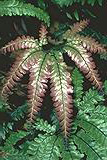
Adiantum hispidulum
Photo: Fred Johnston
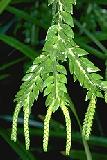
Huperzia phlegmarioides
Photo: Murray Fagg
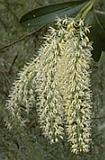
Dendrobium speciosum

Dendrobium x delicatum

Linospadix monostachya
Photo: Murray Fagg
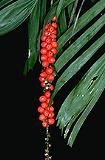
Linospadix monostachya
Photo: Murray Fagg
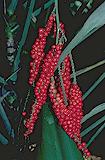
Cordyline petiolaris
Photo: Peter Sparshott
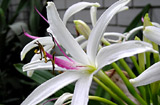
Crinum pedunculatum
Photo: Jeff Howes
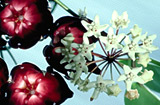
Hoya macgillivrayii
Photo: Keith Townsend
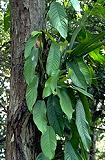
Rhaphidophora australasica
Photo: Murray Fagg
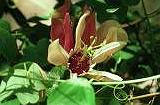
Passiflora aurantia
Photo: Peter Sparshott
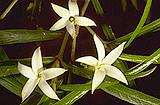
Randia chartacea
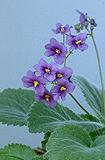
Boea hygroscopica
Photo: Murray Fagg

Tripladenia cunninghamii
Photo: Murray Fagg
|
|
I could choose from three spectacular ferns. I could have the rough maidenhair fern, Adiantum hispidulum, tough and wiry but very showy, especially in new growth, or the beautiful Goniophlebium verrucosum (schellolepis fern, formerly Schellolepis percussa) with its long and gracefully arching light green fronds, or for something really unusual, the long weeping fronds of the tassel ferns, Huperzia species.
Perhaps I should choose orchids. I could have the deservedly well-known king orchid, Dendrobium speciosum, either the pure species or one of the many hybrids between D.speciosum and D.kingianum, now sold under the name of Dendrobium x delicatum. I really love the Christmas orchid, Calanthe triplicata with its lush rich green foliage and long-lasting heads of clean, white flowers, or there's the tough old favourite, Dendrobium gracilicaule, but the flower fragrance of the latter is very bold.
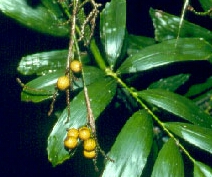
|
Calamus caryotoides
Photo: Hugh Nicholson
|
Palms are another group of popular container plants and I would have great difficulty in overlooking the beautiful walking-stick palm, Linospadix monostachya. A well grown specimen standing 1.5 metres or more with a delicate skirt of long arching fronds laced with equally long spikes of bright red berries is one of the most beautiful plants one could see. The lawyer cane palm, Calamus caryotoides, which has a climbing habit, also makes a very attractive container plant while one of the best palms reaching the market in recent times would have to be the Licuala fan palm, Licuala ramsayi. It is still a little hard to come by, but remains very desirable.
Another useful group are the palm lilies. One of the nicest is the diminutive dwarf palm lily, Cordyline haageana. This is a handsome clumping species with red flowers and it scarcely reaches 50 cm in height. Broad-leaf palm lily, Cordyline petiolaris, is a excellent container plant with unusual foliage. It may be multi-planted for good effect but needs a good big pot to reduce the risk of being blown over in the wind.
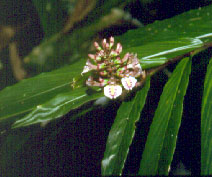
|
Alpinia modesta
Photo: Hugh Nicholson
|
Maybe I should look to the gingers and their relatives. I live at Raymond Terrace, just north of Sydney, and one of the most handsome ginger plants I have here is the little ginger, Alpinia modesta. It performs well in light shade and in containers it forms thick clumps about 50 cm tall. The leaves of Alpinia modesta are reddish green above and deep red below. Another of my favourites is the wavy-leaf ginger, Alpinia arundelliana. It grows a little taller than the former species and has narrow, glossy green leaves with delightful wavy margins.
For something different I could have a costus, Costus potierae. These are somewhat taller again and have unusual, soft, pale green foliage on long canes. The drawback with this plant is that in cooler climates it will die down each winter and even then needs some extra protection.
What about a lily? Lilies are good I could have the spectacular Cape York lily, Curcuma australasica, a relative of the culinary tumeric. Although this plant too, dies down in winter, it is relatively tough and is well worth growing just to see the emergence of the flower spike in spring. The flower heads usually emerge first with spikes of bright pink bracts hiding the yellow flowers. The leaves, which soon follow, are also quite showy.
Weevil lily, Molineria capitulata is another useful container plant. It grows to about 1 metre in height and has long, broad, yellowy-green, closely pleated leaves on long stems. It forms thick clumps and tends to creep out the drainage holes and into the garden if given the chance. In the garden it spreads by underground rhizomes. To these I could add the river lily, Crinum pedunculatum which is a fleshy lily reaching a metre or so in height. The showy clusters of large white fragrant flowers are held on long stalks atop a 50cm spike.
There are always the climbers - say the climbing pandanus, Freycinetia scandens or F.excelsa. These are attractive root climbers and best if supplied with a totem for support. A similar group are the Rhaphidophora which are not unlike the exotic Philodendron. Rhaphidophora australasica, which is available through specialist nurseries, is an easily grown species which has long, glossy, spear shaped leaves which often develop holes or windows.
For something with showy flowers I could have a Hoya or a passion flower. The pink passion flower, Passiflora aurantia, is most unusual. It is a light climber bearing masses of large flowers which open white and gradually age through pink to red, allowing a complete range of colours to be displayed at the same time. It is an excellent container plant and may be grown over a light wire frame.
Eureka! (I've found it!). I could have some topiary specimens. I could have a standing Hill's weeping Fig, Ficus microcarpa var. hillii, clipped to a neat ball, a lilly pilly, Syzygium australe (one of the numerous forms) or Acmena smithii (again one of the many forms available), and this could be trimmed to form a cone or spiral or take some other form. I could have an Austromyrtus inophloia clipped like a Christmas tree.
Naah! I think I would have a firewheel tree, Stenocarpus sinuatus, a native gardenia, Randia fitralanfi, and a salmon muttonwood, Rapanea porosa. All three are easily grown, relatively trouble-free and, where I live at least, they can be grown in the open in full sun throughout the year. The native gardenia, like exotic gardenias, may develop some yellowing of the tip growth if exposed to a lot of full sun during the winter months, but this will green up in summer.
Firewheel Tree
I like these because they are very forgiving and yet can provide quite a showy foliage display. The handsome lobed leaves are deep green, especially if grown in light shade, and very glossy. They have a strong bronzy hue to the new growth. Multiple plantings result in dense full plantings in the pots. The tallest plant (or leader) can be cut down occasionally to maintain a suitable height without spoiling the effect. A similar fullness can be achieved by occasional clipping of a single plant to encourage multi-stemming although this will take longer.
The firewheel tree has few problems apart from an occasional leaf eater or leaf miner and quickly recovers from damage. It is not adversely affected by elevated phosphorus levels in the potting compost. Although flowering in the pot is not out of the question, it could take forever for it to happen; so it is not a reason for choosing this species.
Salmon muttonwood
This is one of my favourites. In recent times some large 'finished' plants in 300 mm pots have been sold through nurseries who specialise in plants for courtyard containers. It is an unusual shrub, rarely exceeding 1.5 metres in a container. The leaf bases, leaf tips and the emerging leaves are deep red while the branchlets, stems and trunk are a deep maroon. The leaves are a soft mist green on both surfaces, glossy above but less so below. The leaf surface has a dense smattering of smooth oil glands easily seen without a lens and these add to the overall attractiveness. The small white flowers which hug the stems are produced in great abundance and these are followed by white, blue, mauve or pink berries. As I have already said it is easily grown and rarely affected by pests. It forms a bushy crown supported by a clean short stem, but it may be clipped to increase the plant density. Overall it is a very handsome shrub.
Native gardenia
This is another of my favourites and, like the salmon muttonwood, is now appearing as a large containerised plant in nurseries in some of Sydney's more affluent suburbs. It has large, rich, deep green leaves up to 20cm long and 7.5 cm wide. The smallish fragrant flowers which are reminiscent of some exotic gardenias are pure white and appear crystalline. It is a plant which benefits from tip pruning from an early age to encourage multi-stemming and generally dense growth. Leaf hoppers can take a toll of the leaves, but they are infrequent seasonal visitors, easily picked from the foliage. The big broad leaves may also be damaged by falling sticks if located under Eucalyptus trees.
|